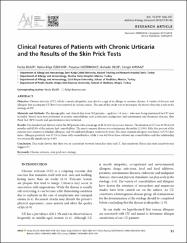Clinical Features of Patients with Chronic Urticaria and the Results of the Skin Prick Tests
Abstract
Objective: Chronic urticaria (CU), which is mostly idiopathic, may also be a sign of an allergic or systemic disease. A variety of diseases and allergens that accompany CU have been reported in various studies. The aim of this study was to investigate the factors that play a role in the etiology of CU. Materials and Methods: The demographic and clinical data from 302 patients-aged over 18 years-who were being monitored for CU were recorded. Several tests were performed to analyze comorbidities such as infection, malignancy, and autoimmune and rheumatic diseases. Skin Prick Test (SPT) results and questionnaires were reviewed. Results: Two hundred and thirteen out of the 302 patients with a mean age of 40.26 +/- 14.3 years were females. The duration of CU was 43.30 +/- 62.60 months and 42.9% of the patients had comorbidities. The most common disease was autoimmune thyroiditis (13.9%). Fifty-five percent of the patients were sensitive to inhalant allergens, and 5% exhibited allergen positivity for food. The most common allergens were house (43.7%) dust mites. Allergen positivity was 37.2% in those with comorbidities, while it was 62.8% in those without any comorbidities and this relationship was statistically significant (p<0.05). Conclusion: This study showed that there was an association between house dust mite and CU dust sensitivity. House dust mite sensitivity may trigger CU.
Source
Astim Allerji ImmunolojiVolume
17Issue
2URI
https://doi.org/10.21911/aai.437https://app.trdizin.gov.tr//makale/TXpJeU1qa3hNUT09
https://hdl.handle.net/20.500.12809/1188


















